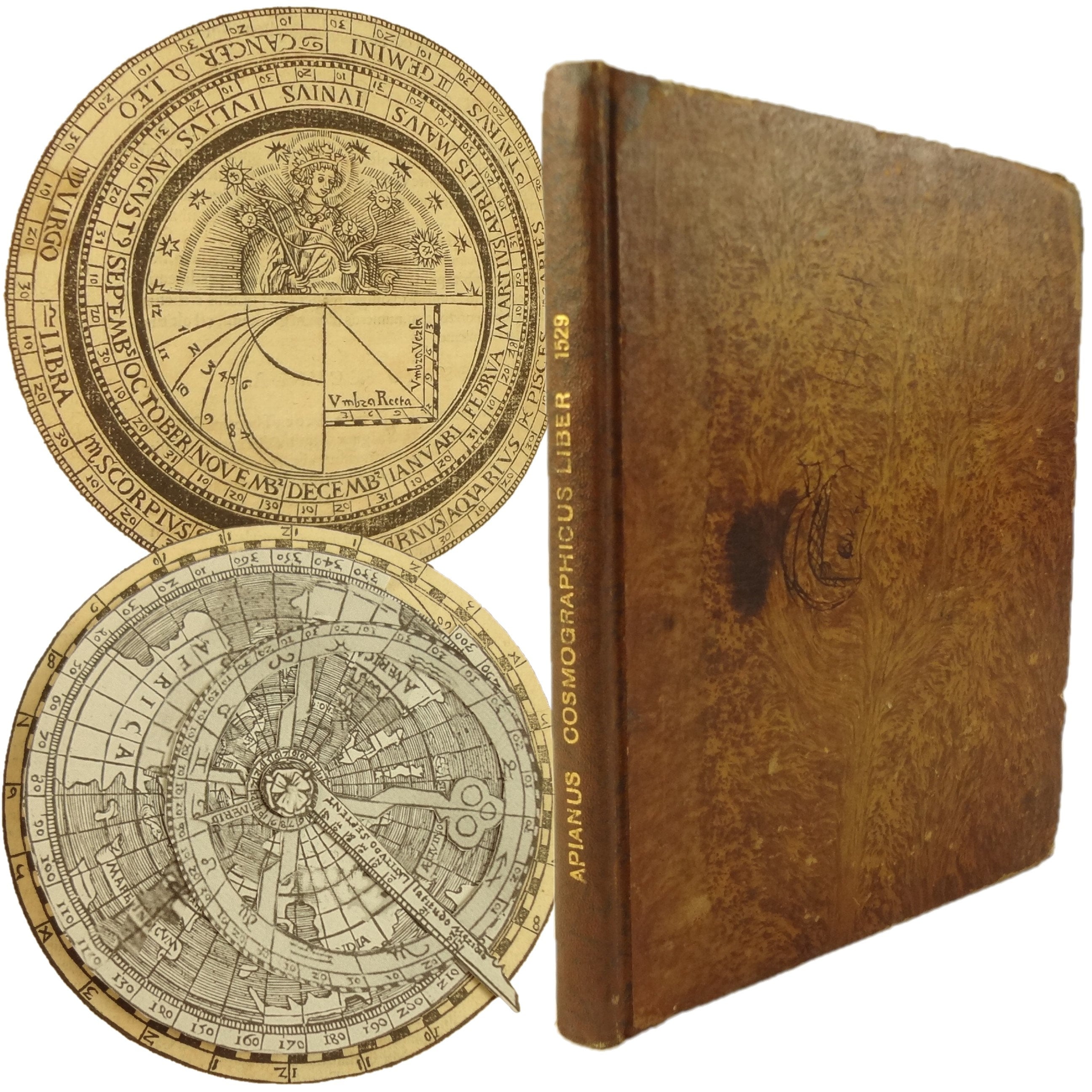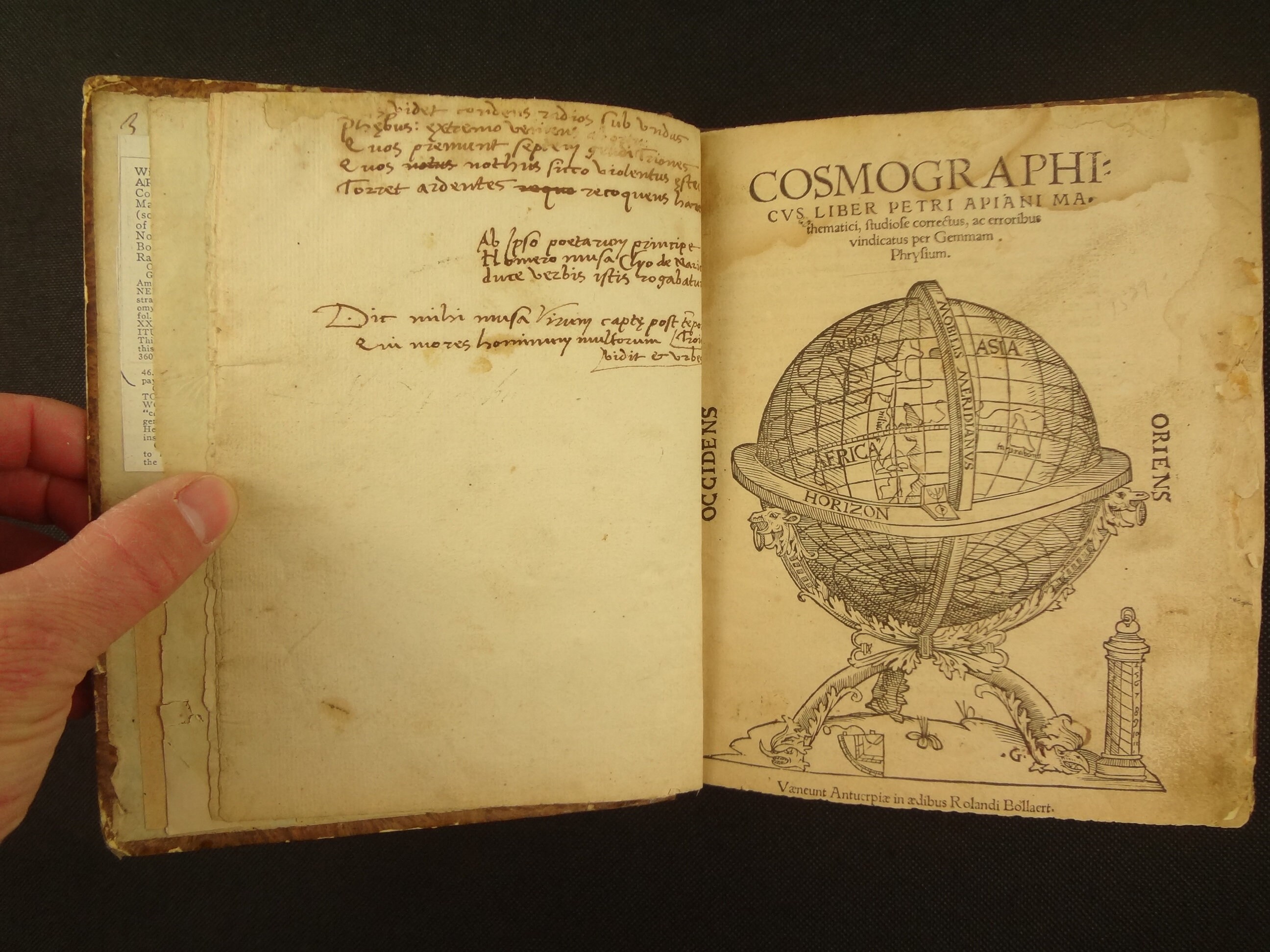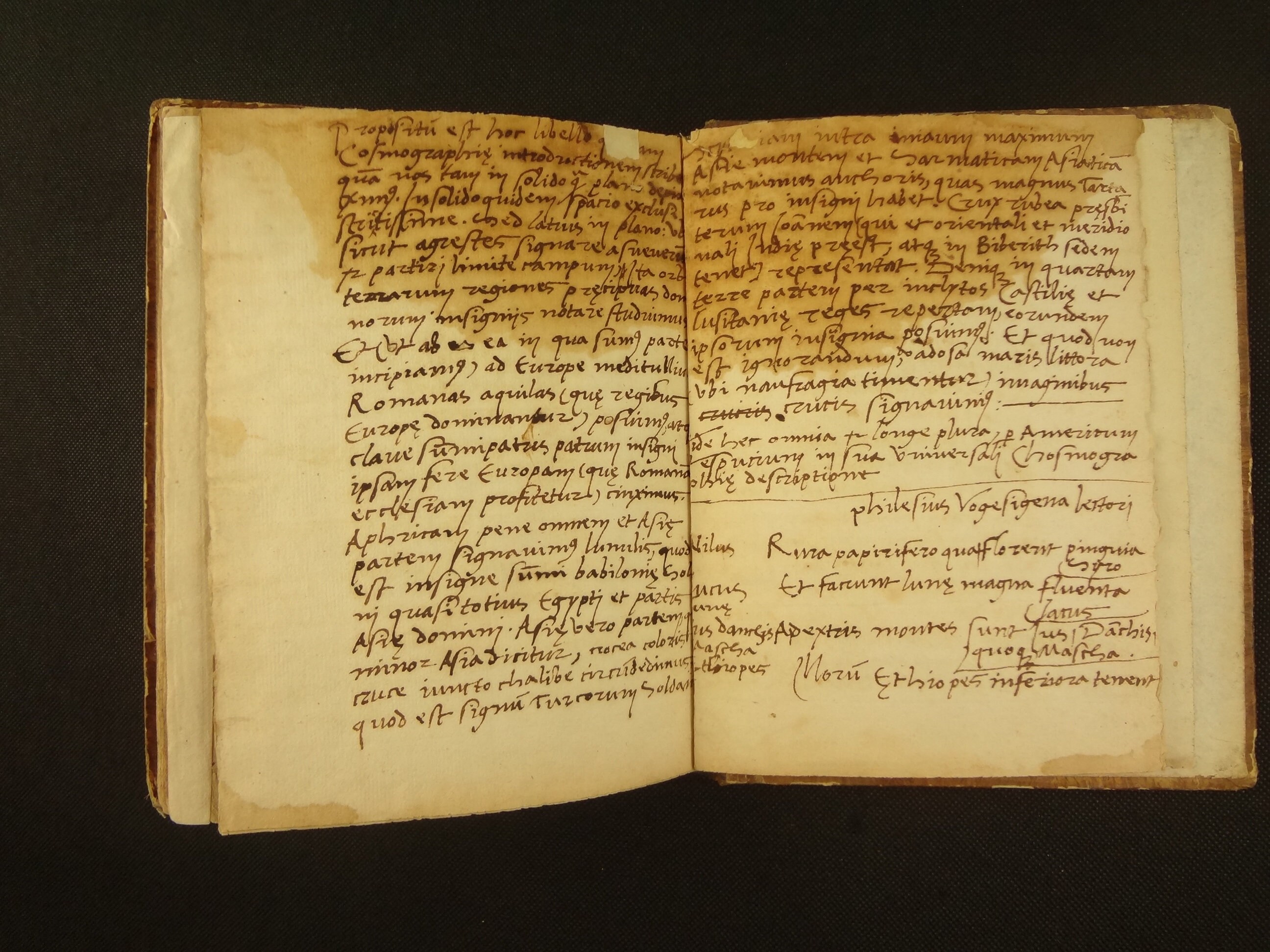1529 Cosmographicus, Petrus Apianus. Woodcuts, maps, volvelles. Antwerp, Bollaert. Gemma Frisius editor.
$3,999.99
The 1529, second edition, of Petrus Apianus' Cosmographicus; this is the first printing edited by Gemma Frisius. This copy's leaves collate complete. This copy also includes interesting "old-hand" annotations (including one on America) and working facsimiles of all the volvelles have been added (more on their construction below).
A map on the verso of leaf Fol. II includes a globe showing "America", leaf Fol. XXXIIII discusses America in the text, and the index provides the latitude and longitude of American points (in the old 360 degree basis). These are very early descriptions and depictions of America in print.
About Cosmographicus -
In 1524 Petrus Apianus printed the first edition of his work on astronomy and navigation, Cosmographicus, which borrowed heavily from earlier works, but presented the concepts in a visually interesting and understandable way, including the use of volvelles, which made Apianus' Cosmographicus remarkably successful (40 reprints in four languages). Adding to the work's popularity was Apianus' inclusion of Vespucci's descriptions of America, which was of immense interest to Europe at the time.
Apianus drew his text from classical and contemporary sources. The enormous-feet people of Sciapodes, and the dog-headed people of Asia, recounted in ancient legend, are here described. Of his contemporaries, Apianus drew from the 1507 Waldseemuller work Cosmographiae Introductio, and Johann Schoner's 1515 Luculentissima..., some scholars even believing Cosmographicus is simply an abridgement of Schoner.
In 1529 Gemma Frisius produced this second edition. The title page states (translated), "studiously corrected, and vindicated of errors by Gemmam Phrysium." Also, on the title page, Gemma has added a "G." to the bottom of the globe woodcut (which has been recut). Frisius edited throughout the work, even adding some text.
Frisius was Apianus' student and, perhaps indicative of a more youthful editing, a woodcut illustrating length was changed to be more suggestive in the phallic region (and in this copy, the suggestion was added to by a previous owner). More importantly, Frisius revised the map of America, on the verso of leaf II, significantly.
The Volvelles and Their Reproductions (Facsimiles) -
A contributing factor to Cosmographicus' success were the volvelles. Volvelles (from the Latin volvere - to spin) were layers of paper, each with information printed on them, that when stacked and spun around a common pole (a thread through them), acted as small computers similar to the ancient astrolabes. Previous works on the cosmos relied heavily on tables, but Apianus' volvelles were easier to use and visually stimulating.
I spent an immense amount of time recreating the volvelles.
First, I found as many pictures/scans of existing 1529 examples as possible. Frisius had the woodcuts re-executed, so the 1524 examples largely couldn't be used. Because the volvelle layers often overlapped, I had to digitally stitch together the pieces from various examples to make complete layers; thankfully, I sometimes found volvelles with pieces missing which allowed me access to complete lower layers.
I'm proud of what I was able to achieve; I was able to recreate all the layers. I will note, the layers are not perfect, as some photos were of a lesser resolution than others (most notable, the world map found on a bottom layer has a few fuzzy areas). Also, the bottom layer of the phases of the moon volvelle - I could only approximate the printing of the dark heart of the volvelle based on what I could see through the upper layer's window on about five examples.
After producing the layers, I had to scale them all to size (many draft printings were wasted in this step). I used the photos to scale my pieces to the same size; for example, the moon phases volvelle seems small, but it is similar to what I saw in other 1529 copies. The 1524 edition's volvelle fit the printed page better.
I printed the layers on thick, acid-free, laid paper, with chain lines, that is normally used for charcoal artists.
This copy of the book has numerous existing volvelle mounts still on the leaves, telling me that parchment was the original base of the volvelle poles. Thankfully, I had some old hard parchment I could use for recreating.
I ran book-binder thread through the center of the volvelles, and on either far end the thread went through pieces of parchment. I would knot the thread, at both ends, over the pieces of parchment. Then, I would glue the printer's decorative cap to the top knot/parchment, and I would glue another piece of parchment to the bottom knot/parchment, making a complete button/pole with the string not exposed.
For the last volvelle, the one that is often found as only two pieces tacked at the last page of the appendix (for the purchaser to assemble), I only tied a knot on either end of the volvelle, in case you wanted to take it apart (as it is found in other copies).
I did not connect the volvelles to the book. They are loose and you place them on top of the appropriate leaves. I did this because they are facsimile, and I did not want to give the appearance that I was trying to "fix" the book. My vision is that this will be an excellent working copy for a learning institution.
If you are set on affixing volvelles, I would suggest a drop of wheat glue (which is reversable by moisture) on the base of the pole parchment; that is all it would take, and it would recreat the original mounting.
Explanation of the volvelles - One is a device for finding the horizon line, one is an altitude sundial, one is a meridian device, and another a lunar clock. At the rear is a device that can be used for finding time at night.
You can see my volvelles working here - https://www.youtube.com/watch?v=VZ9hNDEHA5M
Interesting note: in my research/project, I found an error commonly retold in the bibliographies. Many bibliographies state that Frisius added a volvelle in the 1529 edition. The 1524 edition from the "Bibliotheca Regia Monacensis" (from the title page stamp) is scanned to Google and contains all the volvelles recreated in the 1529 edition. In fact, on leaf "Fol. 50", the 1524 edition includes a volvelle single layer, reused from the volvelle on "Fol. 24", that Frisius didn't take time to include in the 1529 edition. I printed that layer twice, in the 1529 style, so that you could use it on the constellation chart, as the 1524 edition intended.
About the Annotations in this Copy -
Fascinating annotations abound in this copy.
On the verso of the title page, someone added "cum deus astra regat, et terre climata Cesar, nec tellus, nec eis sydera maius habent". This is copied straight from the title page of the 1507 Cosmographiae of Martin Waldseemuller.
The notes, bound in as endpapers, reference several works of antiquity. Notably, at the rear, is a copied manuscript section authored by Philesius Vogesigena (Matthias Ringmann), taken from the 1507 Cosmographie, "Orbis terrarum regiones praecipuas dominorum insigniis notare studuimus . Et ( ut ab ea in qua sumus parte incipiamus ) ad Europe meditullium Rhomanas aquilas ( que regi- bus Europe dominantur ) posuimus atque clave summi patris patrum insigni ipsam fere Europam ( que Rhomanam ecclesiam profitetur ) cinximus . Aphricam pene omnem et Asie partem signavimus lunulis , quod est insigne summi Babilonie Soldani quasi totius Egypti et partis Asie domini . Asie vero partem que minor Asia dicitur , crocea coloris cruce iuncto chalybe circumdedimus , quod est signum Thurcorum Soldani . Scythiam intra imaum maximum Asie montem et Sarmaticam Asiaticam notavimus anchoris , quas magnus Tartarus pro insigni habet . Crux rubea presbyterum Joannem ( qui et orien- tali et meridionali Indie preest atque in Biberith sedem tenet ) representat . Denique in quartam terre partem per inclytos Castilie et Lusitanie reges repertam eorundem ipso- rum insignia posuimus."
Roughly translated, "We have endeavored to mark the principal regions of the world with the insignia of the lords. And (in order to begin from that part in which we are) we have placed the Roman eagles (which dominate the kings of Europe) in the middle of Europe, and with the key of the most distinguished fathers we have encircled almost Europe itself (which represents the Roman church). We have marked almost the whole of Africa and part of Asia with moons, which is the sign of the supreme ruler of Babylon as lord of all Egypt and part of Asia. But in Asia, the part which is called Asia Minor, we have surrounded the cross of the color of a cross joined with steel, which is the sign of the Sultan of the Turks. We have noted Scythia within the lowest mountain of Asia, and Asiatic Sarmatics, as anchors, which the great Tartarus holds as a sign. The red cross represents the presbyter John (who presides over eastern and southern India and holds his seat in Biberith). Finally, in the fourth part of the land discovered by the illustrious kings of Castile and Lusitania, we placed the same insignia."
This section is Vogelsigena's description of the map he produced for the 1507 Cosmographiae, which is widely known as the first map of America.
Whoever annotated this copy was familiar with the earlier cosmography works that mentioned America, and was specifically interested in America.
Leaf of Instructions -
Someone added a printed leaf, on laid paper, that gives instructions for putting together an Apianus volvelle. A handwritten note, on the back of the leaf, suggests it might have come from our edition, but I believe it to have come from a later edition and I found the same
instructions (although in a different typographical layout) in a later edition.
Bibliographic Information -
Universal Short Title Catalogue number 403800. 30 copies in the world's libraries. Four in America (Houghton, Newberry, NYPL, Brown University).
Pettegree and Walsby, Netherlandish Books, reference 2394
Joseph Sabin, A Dictionary of Books Relating to America (1868), reference 1739
Physical Attributes -
Book measures approx. 19.7 x 15.7 x 1.5 cm, quarto. Illustrated. Maps. Volvelle reproductions.
Binding is an 18th century French tree-calf which has been respined (old repair) with cloth simulating leather. Title on spine in gilt, with year and author.
Pages - Fol LVI (56 leaves)
Collation - A to 04
Condition -
Please also refer to the pictures.
Volvelles are all facsimiles.
Binding - 18th century tree-calf boards quite worn, with rubbing, as well as corner and edge wear; also, woman's portrait drawn on front board. Respined, and re-hinged, rather rudimentary; older repair using brown cloth simulating leather. Copious bookseller notes written on, and pasted on front endpaper; under, older library marks in old hand. Chipping to edges of flyleaf. Remnants of old notes used as front and rear endpapers.
Text block - is toned throughout, with water marks from top and fore-edge top edge extends into text but the fore-edge mark mostly stays in the margin. The book is also heavily thumbed. Title page and following three leaves with fore-edge chipping. Annotated on verso of title page leaf, a note at leaf III, a lengthy note at the America leaf, and one more inscription at the last printed leaf, in an old hand. Graphite "1529" written on title page. The book did have tears. You can tell the tears were repaired with tape, but someone removed the tape (leaving tape ghost) and used paper fiber to repair; still, leaf xv is not entirely repaired. Hole in leaf IX at center of illustration, where the volvelle was pulled through. Occasional page edge chips. Recto of XII, which has volvelle on verso, has spot on recto caused by volvelle. 1" tear bottom edge of XVII not repaired. Inappropriate phallic addition added to the already questionable woodcut on the verso of XVII. Some pages feel a little shaken, especially at the bottom gutter. Drawing of compass at bottom of XXVI. From XLV to rear, moisture mark is also at bottom edge and extends farther in at fore-edge. Appendix fore-edge trimmed tight, cutting "Oriens" on volvelle leaf. Rear colophon with moisture mark across it. Several fore-edges with an older strengthening by pasting on paper.
Summary - Despite wear, the cloth hinges are holding it together well, and the leaves collate complete. It does not have the fancy two-page map (Charta Cosmographica) found in the 1524 Cosmographicus, but I have looked at numerous copies of the 1529 edition and none of them included that map; I think the 1529 edition may have been cheapened for student use (which also, perhaps, explains the inappropriate phallic addition to the woodcut on lengths). The thumbing, notes in an old hand, and etc., give the impression that this copy has long been used in study, which adds some sense of importance.
Shipping from United States
Processing time
1-3 business days
Customs and import taxes
Buyers are responsible for any customs and import taxes that may apply. I'm not responsible for delays due to customs.
Payment Options
Returns & Exchanges
I gladly accept returns
Just contact me within: 7 days of delivery
Ship items back to me within: 14 days of delivery
I don't accept exchanges or cancellations
But please contact me if you have any problems with your order.
Conditions of return
Buyers are responsible for return shipping costs. If the item is not returned in its original condition, the buyer is responsible for any loss in value.
Privacy policy
We do not collect any private information. For billing, Etsy provides the service. We only receive notice that payment was made. The shipping address is provided to us by Etsy, based on what they buyer submitted during check-out. We do not store these addresses. That is the extent of the information that we receive during a transaction.









